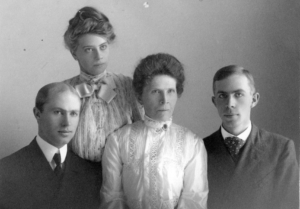Who was Hume White…and why did he need an opera hat?
Sometimes local history arrives unexpectedly. In the case of Hume Stanley White, it was the donation of a collapsible opera hat that first piqued the Eagle County Historical Society’s interest in this Eagle County pioneer. When collapsed, the hat, which has an internal spring system, looks like a flattened black silk pancake. Pop it up, and it’s a shiny top hat, suitable for a society event. Couple that hat with a box full of yellowed papers that came from Hume White’s roll top desk, add in the research time made available courtesy of the spring of 2020 corona virus epidemic, and this pioneer story comes into focus.

George White [Courtesy of ECHS and EVLD]

Sarah Anne Morton White [courtesy of ECHS and EVLD]
George quickly established a successful legal practice. In 1876, he helped write the Colorado Constitution. Eventually, his adventurous nature drew the White family to the bustling Leadville mining camp, where he served as a judge. In 1891, the Whites went exploring down the Eagle River, and found the country along Brush Creek (south of Eagle) promising enough to prompt them to file several homestead claims. Those homesteads encompassed 480 acres including what is now the heart of the Eagle Ranch subdivision, and rural properties farther up the creek.

Barn on Sarah White Ranch [courtesy of ECHS and EVLD]
The widow Sarah proved her strength and independence by establishing a cattle ranch on the Brush Creek property, where she raised her children. Determined to provide her children with a high quality education, Sarah’s success at the ranch, along with the money left by her husband, enabled her to send her children to boarding schools. The boys, Ben and Hume, completed their elementary education at Notre Dame. Hume spent his higher education years at William Jewel Academy College in Missouri, completing college in 1905, the same year that his mother died after a several-month illness.

Sarah White and Family [courtesy of ECHS and EVLD]
Hume began his law practice in Denver, working in the office of his father’s former law partner. In 1913, Hume married Genevieve Fisher Chilson. Several perfectly preserved engraved wedding announcements were among the papers in Hume’s rolltop desk.
From 1916 until 1920, he worked as a Deputy District Attorney, prosecuting criminals in the City and County of Denver.
But he always had strong ties to Eagle County, where he enjoyed the ranching, the hunting and fishing. When silver was discovered at Horse Mountain on Brush Creek in 1913, Hume was one of the investors in silver mines.

Hume White House, Eagle [Courtesy ECHS and EVLD]
Like his father, Hume was a skillful lawyer. The family memoirs claim he never lost a case. He was also a politically savvy Democrat. He represented Eagle County in the State Legislature from 1922-1924, a job that probably required the occasional use of a formal opera hat. His work included stints as the Eagle town attorney, Eagle County attorney, and a term as a District Court judge.
Hume was the vice-president of the First National Bank of Eagle County. He served on the Colorado River Water Conservation Board for 23 years, including the time during the late 1940s and early 1950s when the controversial Fryingpan-Arkansas water diversion project (resulting eventually in the construction of Ruedi Reservoir) was taking shape. Hume White was well known in Democratic Party circles throughout the state; and in 1936 was a delegate to the National Democratic Convention.

Hume Stanley White [courtesy ECHS and EVLD]
Genevieve White died in 1951. Hume White retired from his law practice but remained prominent in county affairs. He died 1968. The opera hat and the desk drawer of papers are small artifacts of the accomplishments of a man who played a big role in Eagle County.

[courtesy of ECHS and EVLD]
Complied by Kathy Heicher
Eagle County Historical Society
April 25, 2020
